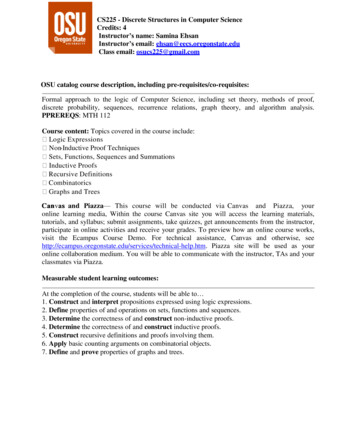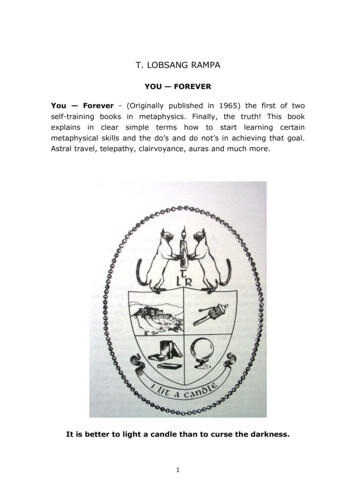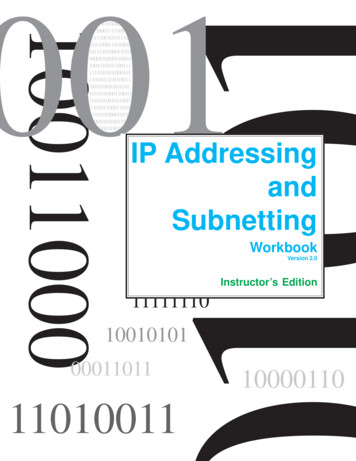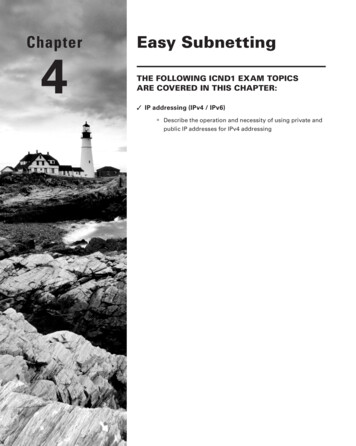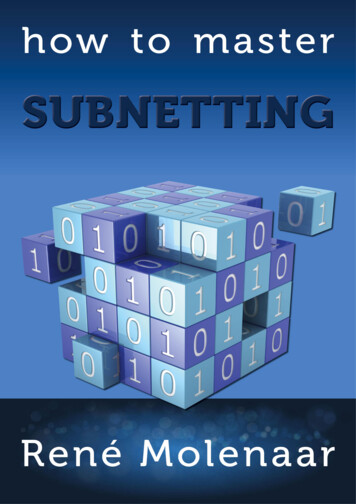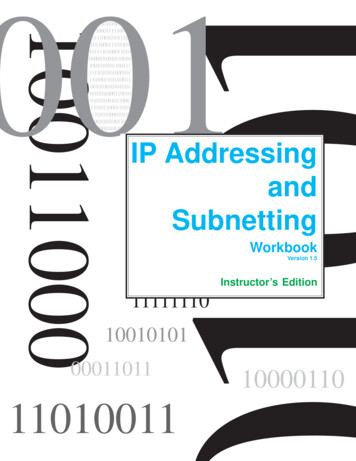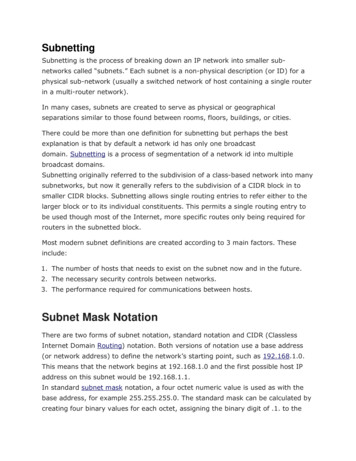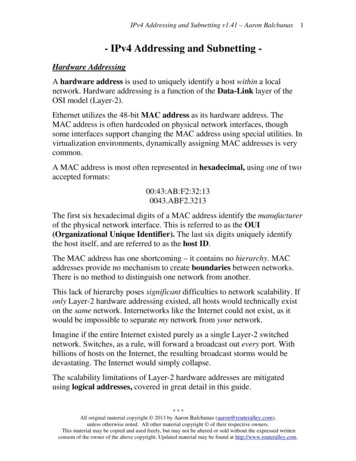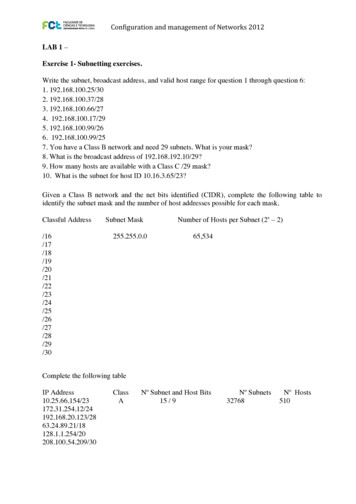
Transcription
Mastering IPSubnetting ForeverBRKCRT-9346Scott Morris & Keith Barker2
Tour Guide Scott Morris, CCIEx4 #4713, CCDE #2009::13,JNCIEx2– CCIE Route & Switch, ISP/Dial, Security, Service Provider– Cisco Certified Design Expert– Juniper Networks JNCIE-M #153 and JNCIE-ER #102– CISSP, CCVP and several other random things!– Email: Scott.Morris@CopperRiverIT.com– Twitting: @ScottMorrisCCIEBRKCRT-9346 2013 Cisco and/or its affiliates. All rights reserved.Cisco Public3
Tour Guide Keith Barker, CCIEx2 #6783, CCDP, CCSI– CCIE Route & Switch, Security– HP-MASE, Brocade BCNP– Juniper Networks JNCIS-ENT/SP– Twitter: @KeithBarkerCCIE– YouTube: Keith6783BRKCRT-9346 2013 Cisco and/or its affiliates. All rights reserved.Cisco Public4
Journey Understanding an IPv4 Address Mastering the Mask Custom Subnetting VLSM and BeyondBRKCRT-9346 2013 Cisco and/or its affiliates. All rights reserved.Cisco Public5
IPv4 Agenda Setting the stage–Why the mastery of IP Subnetting skills is so important in the real world–What we know or think we know, can be a factor in our mastery Key elements in successful execution of the subnetting procedure–Creating a MB-Key, identifying the need in the network, and using yourthumbs (and other digits) to create a subnetting addressing scheme Reverse Engineering any IP Addressing scheme–The magic of application in the real world Extending our IP Subnetting knowledgeinto Classless schemes—VLSM and CIDR–Variable Length Subnet Masking–Classless Inter-Domain Routing (Address Summarization,Supernetting, IP Address Aggregation)BRKCRT-9346 2013 Cisco and/or its affiliates. All rights reserved.Cisco Public6
What You Will Need To Be Successful Something to write with, and write on An open mind –If you have failed to master IP subnetting before, it’sok –If you are already a ‘Jedi Master Subnetter’, this sessionmay not be for you or you just may learn a shortcut youhaven’t used before Be willing to practice on your own if you don’t use it, you WILL lose it Fill out your session evaluationBRKCRT-9346 2013 Cisco and/or its affiliates. All rights reserved.Cisco Public7
8
Let’s play everyone’s favorite game called Guess that network!BRKCRT-9346 2013 Cisco and/or its affiliates. All rights reserved.Cisco Public9
What We Know Already or Maybe NotBRKCRT-9346 2013 Cisco and/or its affiliates. All rights reserved.Cisco Public10
What We Know Already or Maybe NotBRKCRT-9346 2013 Cisco and/or its affiliates. All rights reserved.Cisco Public11
What We Know Already or Should An IPv4 address is 32 bits long—4 separate bytes An IP address is represented in dotted-decimalnotation–Each byte is represented by a decimal number separatedby a period (called “dotted decimal” notation)–Example: 10.100.30.4 or (010.100.030.004)–Each byte represented as decimal number (0–255) The first byte may be the most important to youwhen you start BRKCRT-9346 2013 Cisco and/or its affiliates. All rights reserved.Cisco Public12
What We Know or Should (Cont.) There are three (3) usable unicast IP address classes - A, B and C The first byte/number/octet identifies the class that the IP belongsto—“Classification”–Correct Classification is a starting point, for mastering IP subnettingBRKCRT-9346ClassExample# of Networks# of Hostson eachnetworkA – 1-12724. 0 .0 .012716,777,214B – 128-191150.18. 0 .016,38465,534C – 192-223198.23.210. 02,097,152254D – 224-239224.0.0.10MulticastE – 240-255Reserved 2013 Cisco and/or its affiliates. All rights reserved.Cisco Public13
Let’s play Name that class!BRKCRT-9346 2013 Cisco and/or its affiliates. All rights reserved.Cisco Public14
Practice: Classification—What Classdoes each IP below belong to?BRKCRT-9346 2013 Cisco and/or its affiliates. All rights reserved.Cisco Public15
Practice: Classification—What Class?BRKCRT-9346 2013 Cisco and/or its affiliates. All rights reserved.Cisco Public16
17
EachIP address hastwoClassparts: MattersWhyKnowingthe– Network Number12Host Number Each class uses a different default mask, as adefault point of separation between Network andHost–Referred to as the “Class Boundary” (note the lineposition)BRKCRT-9346ClassExampleNetworksHostsA – 1-12724. 0 .0 .012716,777,214B – 128-191150.18. 0 .016,38465,534C – 192-223198.23.210. 02,097,152254 2013 Cisco and/or its affiliates. All rights reserved.Cisco Public18
Please put your thinking capson, it is time for a quiz.One, two, three .BRKCRT-9346 2013 Cisco and/or its affiliates. All rights reserved.Cisco Public19
Practice: Class Boundary—Draw the default LineBRKCRT-9346 2013 Cisco and/or its affiliates. All rights reserved.Cisco Public20
Practice: Class Boundary—Draw the Line (Cont.)BRKCRT-9346 2013 Cisco and/or its affiliates. All rights reserved.Cisco Public21
How the Line Is Defined In a classful address, every number to the left of theline is static, and represents the “street” or “network”name.–Classful addresses, left in their classful state,yield exactly ‘1’ subnet (or street)–Every number right of the line is ours to use for what?Host addresses and/or creating custom subnets All bits in the mask to the left of the line are set to abinary 1 (which indicates those bits are network bits)–This identifies the Network portion of the address.–The network portion of the address is MASKED with1sBRKCRT-9346 2013 Cisco and/or its affiliates. All rights reserved.Cisco Public22
10.1.0.2000000 1010. 0000 0001 . 0000 0000 . 1100 10001111 1111. 0000 0000 . 0000 0000 . 0000 0000Network Host bits . Host bits . Host bitsBRKCRT-9346 2013 Cisco and/or its affiliates. All rights reserved.Cisco Public23
Subnet Mask—Where We Draw theLine Identifies the division between the Network and theHost portion of an IP Address All devices on common network share the samemask, and network bits (same street name). The default mask is the number of bits that arereserved by the address class—Default Line position–Using the default mask will accommodate only onenetwork (no custom subnets) in the relative class A custom Subnet Mask can be defined by anadministrator to accommodate new subnetworks.Done by moving the the dividing line to the right.BRKCRT-9346 2013 Cisco and/or its affiliates. All rights reserved.Cisco Public24
Using the Default ‘Class’ Mask12BRKCRT-9346 2013 Cisco and/or its affiliates. All rights reserved.Cisco Public25
Using a Custom Subnet Mask12BRKCRT-9346 2013 Cisco and/or its affiliates. All rights reserved.Cisco Public26
The Question of the Moment Why are IPv4 Subnetting skills so important in thereal world?–It is what makes it relevant to you and yoursituation that makes it important BRKCRT-9346 2013 Cisco and/or its affiliates. All rights reserved.Cisco Public27
Understanding the CustomSubnet Mask It is the key to mastering the IP subnetting process–Classful subnetting, classless (VLSM), CIDR, supernetting,–summarization, address aggregation – you name it–the customization of the mask is KEYBRKCRT-9346 2013 Cisco and/or its affiliates. All rights reserved.Cisco Public28
Before Starting the IP Subnetting Process Determine the type of IP addressing to use–Become familiar with reserved addresses (RFC 1918, 5735) Determine your network requirements–Number of subnets and hosts your implementation requires Identify your base address (Starting point, class A, B, or C) Write out, and use the “MB-Key” and prepare to use the thumbgame.BRKCRT-9346 2013 Cisco and/or its affiliates. All rights reserved.Cisco Public29
Identify Subnetting Requirements Identify the total number of subnets requiring aunique address:–Unique address required for each LAN subnet–Unique address required for each WAN subnet Verify how many hosts are needed per subnet Identify and create a subnet mask that accommodatesthe design–This is where the movement of the line will extend the maskto go beyond its default (moving the mask to the right, bit bybit).BRKCRT-9346 2013 Cisco and/or its affiliates. All rights reserved.Cisco Public30
Create the Morris/Barker Key (MB-Key) Start with finger row, left to right, then Block Size row right to left, then MaskValue row, left to right.BRKCRT-9346 2013 Cisco and/or its affiliates. All rights reserved.Cisco Public31
Getting to know the MB-Key This is the primary tool that makes the process so easy–This box represents any single number in an IP addressbyte (1 octet) and may be created in pencil or pen (ordigitally).BRKCRT-9346 2013 Cisco and/or its affiliates. All rights reserved.Cisco Public32
Subnetting Review Classification–A, B or C class boundary (class determines the default mask) Line position identifies where the subnet mask “on” bitsend–Moved further to the right gives you more subnets, but at thesame time is restricting how many hosts can be on that subnet Network subnetting requirements–Number of subnets required and making sure enough room fordesired hosts. The MB-Key–Provides many of the answers needed to accomplish thesubnetting tasks–The network block size, determined from the key, will be VERYhelpfulBRKCRT-9346 2013 Cisco and/or its affiliates. All rights reserved.Cisco Public33
The process for subnetting Classify the address!!!–Is it A, B, or C, and what is the default mask. What are your needs?–How many total subnet are to be created?–On a single subnet, how many hosts do you need to support? Create a custom subnet mask for the entire network–Accomplished by moving the Line to the right (increasing thebits that are “on” in the mask.) Determine subnet ranges, as well as the first, last and broadcastaddresses for each new subnet.BRKCRT-9346 2013 Cisco and/or its affiliates. All rights reserved.Cisco Public34
A Fantastic Option for “Qty” questions.How many bits, above and beyond the default mask, do we need toallocate as “network bits” to create new subnets?Answer:Play the Finger/thumb game.Example:You need 20 new subnets.(prepare your thumb, which has a “2” on it)2(We will walk you through this, right now. Please stand up)BRKCRT-9346 2013 Cisco and/or its affiliates. All rights reserved.Cisco Public35
Subnetting Example 1:IP Network DesignCentral Office— Orlando23 Ethernet segments—200 hosts persubnet23 8 12 11 3 57Branch Office—Lexington8 Ethernet segments— 50hosts per subnetMaximum number of hosts on anyone subnet will be 200Branch Office—Detroit11 Ethernet segments— 50 hosts per subnetBranch Office—Las Vegas12 Ethernet segments—150 hosts per subnetBRKCRT-9346172.16.0.0 /16 should be used. 2013 Cisco and/or its affiliates. All rights reserved.Cisco Public36
Regarding any quantity question, usethe thumb game. The goal is at least 57subnets.37
Subnetting Example 12 Base Address: Sample design indicates accommodation of 57subnets (Including WAN) with no more than 200 hostsper subnet (Including router interfaces)–57 is the key factor here.We need to support at least 57 subnets, which will require6 additional bits (stolen from the host portion) assigned torepresent network address.–Mask (the ON bits) will grow/move 6 positions to theright.BRKCRT-9346 2013 Cisco and/or its affiliates. All rights reserved.Cisco Public38
After we move the mask 6 positions, theMB-Key tells us the new mask.Octet 1Octet 2Octet 364BRKCRT-9346 2013 Cisco and/or its affiliates. All rights reserved.Cisco Public39
What We Are Left with for Host IPs? Remember the original network design requirements:–57 Subnets needed—we ended up with 64 (a few extra).–Maximum 200 hosts per subnet—there are 254 addressavailable in Octet 4 alone (8 bits) and we have 10 bits touse.We can use the thumb game (with host bits), to identifyhow may hosts will fit into the host address space (fingersrepresent host bits).BRKCRT-9346 2013 Cisco and/or its affiliates. All rights reserved.Cisco Public40
Where We Are in the Process Classify the address!!!–Identify the class A-B-C–Draw the initial Line–Fill in the default mask information Obtain information about your network–How many total subnets are to be created? 57–On a single subnet, what is the maximum number of hosts needed? 200 Create a custom subnet mask for the entire network–Accomplished by moving the Line to the right–New Subnet Mask number is left of the Line Position The Line Position provides more information–Find the number directly below the chosen mask value—This is the blocksize will give you everything you need to complete the process Subnet addresses Range of host IDs Broadcast addressesBRKCRT-9346 2013 Cisco and/or its affiliates. All rights reserved.Cisco Public41
Block Size MattersBRKCRT-9346 2013 Cisco and/or its affiliates. All rights reserved.Cisco Public42
Completing the Last Step in the ProcessOctet 3 The Block Size Increment Value is used to determineall subnets, host ranges and broadcast addresses.BRKCRT-9346 2013 Cisco and/or its affiliates. All rights reserved.Cisco Public43
Allocating the Subnet, Host, and BroadcastAddresses Using 4 , the ‘Block Size’BRKCRT-9346 2013 Cisco and/or its affiliates. All rights reserved.Cisco Public44
Question:If we take some of the host bits, andnow use them to be part of the networkaddress, don’t we now have less “hostbits” than before?How many host addresses do we haveavailable on each subnet?BRKCRT-9346 2013 Cisco and/or its affiliates. All rights reserved.Cisco Public45
Regarding any quantity question, use thethumb/finger game. The goal this time is tosee how many hosts, can be given addresseson each new subnet, based on how manyhost bits are still available.BRKCRT-9346 2013 Cisco and/or its affiliates. All rights reserved.Cisco Public46
Number of Valid Host IPs Per Subnet To determine how many hosts can exist per subnet,use the thumb game, and verbally count out the numberof host bits (bits not taken by the mask, starting from theright). In our case it is 10 bits (1024) and subt
Network subnetting requirements –Number of subnets required and making sure enough room for desired hosts. The MB-Key –Provides many of the answers needed to accomplish the subnetting tasks –The network block size, determined from the key, will be VERY helpful Subnetting Review 33File Size: 2MBPage Count: 71

